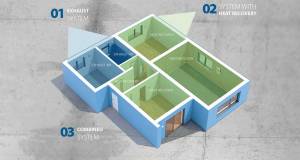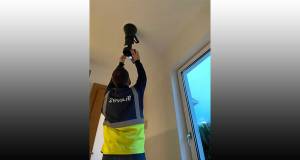- Design Approaches
- Posted
Sound Advice - Acoustic solutions

When designing and building high density apartment and housing developments, the attention, so often lacking, to acoustic performance, can have a critical impact on the quality of life of the buildings’ inhabitants, as leading acoustic consultant Jim Dunne, Managing Director of Integrated Acoustic Solutions explains.
An Inadequate level of sound insulation between adjacent dwellings has been identified as a major problem with many of the newly constructed houses and apartments in Ireland and is one that may be a potential cause of social disruption.
With the tendency towards higher density residential accommodation and the ongoing evolution of the 24-hour society, people who are living directly adjacent to each other may well be living completely different lifestyles. Rest and relaxation time for one person may be sleeping time for another. In this type of situation is not hard to understand how relationships between neighbours can easily breakdown. If one person’s sleeping patterns are disturbed by another person’s normal activities this can easily give rise to the impression that your neighbours are insensitive and inconsiderate.
Noise from neighbours is often cited as a reason for dissatisfaction with the quality of accommodation. It is also a significant motivating factor with regard to wishing to move from one’s present home to a new location. For some people the option of moving home is not a viable alternative. This may be due to a variety of reasons. For instance, a lack of finance, or proximity to work or family may limit the ability of a person to move to alternative accommodation. In these circumstances noise from adjacent properties at best can cause inconvenience and at worst may impact negatively upon a person’s health and well-being.
In many cases noises impacting upon a person from a directly adjoining building may well be coming from normal habitation activities. Many people complain of being able to hear noise from a neighbour’s conversation. Sounds from televisions and radios are often cited as sources of noise nuisance. With the ready availability of home entertainment surround sound systems complete with base sub-woofer speakers, music is also a major offender.
People often feel unable or unwilling to either discuss or complain to their neighbors about any noise that is generated from what could only be described as normal habitation related activities. They fear that this will cause bad feeling and friction between the parties. People who are affected by this type of noise also become very aware of the fact that they too could be a source of noise. In some cases this type of situation can cause such a person to become unduly conscious about the noise they are creating and make them feel like a prisoner in their own home. The overall increased levels of stress and anxiety may lead to health related problems.
Part E of the Building Regulations 1997 set the standards with regard to sound insulation for domestic dwellings. The regulation covers both airborne and impact sound insulation. Airborne sound insulation refers to noise across party walls and floors. Impact sound insulation refers to impact noise between multi floor dwellings such as apartments.
Table 1 details the necessary levels of sound insulation for both airborne and impact sound insulation in order to achieve compliance with the Building Regulations:

The regulations require that airborne sound insulation tests are carried out in accordance with ISO 140-4 Field Measurement of Airborne Sound Insulation. The single figure descriptor DnT,w (Standard Airborne Sound Pressure Level) describes the airborne sound insulation properties of either of party floor or party wall and is derived in accordance with ISO 717-1.
With regard to impact sound insulation, ISO 140-7 “Field Measurement of Impact Sound Insulations” is the standard used to measure impact sound insulation. The single figure descriptor DnT,w (Standard Airborne Sound Pressure Level) describes the impact sound insulation properties of party a floor and is derived in accordance with ISO 717-2.
One of the key issues to note about the above methods, which are used to rate both the airborne and impact sound properties of a given structure, is that they are field tests. As such they measure not only the direct sound insulation performance of a given party wall or floor but also the surrounding structures.
The transmission of sound between two rooms is determined not simply by the insulation of the intervening partition. Flanking paths must also be considered. These paths are not only associated with partition walls but also adjacent interior and external walls, floors and ceilings. These are usually structure borne paths through which vibration energy can travel.
In practice, in the field test, it is the overall performance that is required, as the occupants of the receiving room are affected by the problem of noise coming from the source room regardless of the room it has taken. It is therefore R’ that must be measured.

This is in direct contrast to laboratory measurements for identical structures in which the surrounding elements are much more substantial than those found in a domestic dwelling. As a consequence the sound insulation results derived from laboratory measurements are always greater than those achieved using identical constructions in standard domestic buildings. Therefore it is always wise to de-rate laboratory results by at least 3 to 5dB when considering their use in conventional building situations.
It must be pointed out that the levels of sound insulation specified by Part E of the Building Regulations 1997 are minimum standards. They are not a guarantee of high levels of acoustic comfort. As an acoustic consultant I am regularly called out to conduct sound testing in order to assess the sound insulation performance of party walls in particular. On a number of occasions I have found that even though occupants complained that they could clearly hear noise from the adjoining dwelling, the measured sound insulation of the partition walls were in compliance with the regulations.

In a paper researched by J.S. Bradley of the National Research Council Canada entitled “Acceptable party wall sound insulation criteria” it was concluded that for most types of common noise associated with domestic dwellings the benefits of sound insulation only occur when the Sound Transmission Class (STC) rating is substantially above STC 50. At STC 60 residents would not hear sounds from their neighbours at all and would not be annoyed by them. It is not possible to directly equate STC, which is an American standard, with DnT,w, which is an ISO standard used in Ireland . Suffice to say that the current minimum Irish standard is below the STC 60 as recommended by the National Research Council Canada.
However it must be pointed out that it is possible to deliver very high levels (well above the minimum standard) of sound insulation using existing systems and methods of construction, but for this to become a regular and repeatable reality it will require an upping of the current standards. This surely must be possible, especially considering the cost of an average house in any part of Ireland today.
One of the key drivers with regard to achieving high levels of sound insulation is the quality of workmanship. Every piece of material has some sound insulation properties but how well it performs is directly related to the care and attention that takes place during the construction phase. One point to note is that in order to achieve 50dB of sound insulation the original sound level must be reduced to 1/1,000,000 of its initial level. This is a very substantial reduction especially when a 6mm hole can reduce the sound insulation performance by 10dB.
Good levels of sound insulation between adjacent dwellings will not be achieved by accident. Care and attention is required at every phase of the design and construction process. Every aspect of the development, from the layout to the selection of construction materials, from the method of building to the quality of workmanship and the diligence of supervision staff must be optimised to deliver the required outcomes. By engaging the services of a suitably qualified and experienced acoustic consultant many of the most obvious and regularly repeated mistakes can be avoided. The field of acoustics is not as straight forward a science as it may sound and on a number of occasions I have found that sound insulation problems have been exacerbated by adding additional elements to a given construction. Sometimes the level of sound insulation can be greatly improved by reducing the various components used in the construction and simplifying the build.
The fact that an acoustic consultant is part of the design and construction team often has the net effect of improving the final outcome with regard to sound insulation. When it is known that sound insulation testing will be carried out it often has the desirable effect of improving workmanship standards. It also ensures that problems are identified at an early stage and rectified as the opportunity arises.
With regard to acoustic consultants it is recommended that they are full members of the Institute of Acoustics and that they are experienced in the field of Architectural Acoustics.
In conclusion it must be stated that the costs of delivering high levels of sound insulation at the initial construction stage pale into insignificance if it proves necessary to return to site to rectify problems at a later date. Purchasers of new houses and apartments are increasingly aware of the horror stories associated with poor levels of sound insulation in new domestic dwellings. They are also very aware of their rights and will not be fobbed off with vague answers or assurances with regard to compliance with building regulations. In many cases they are often more informed than construction professionals such as developers, contractors and architects. So don’t take sound insulation for granted—the construction of dwellings which are shown to deliver superior levels of sound insulation can deliver a major marketing opportunity for the discerning and forward thinking developer.
For further information contact Integrated Acoustic Solutions at This email address is being protected from spambots. You need JavaScript enabled to view it.
- acoustic performance
- Integrated Acoustic Solutions
- sound insulation
- noise pollution
- Part E of the Building Regulations 1997
- Jim Dunne
- Ventilation
- glazing
Related items
-
 Why airtightness, moisture and ventilation matter for passive house
Why airtightness, moisture and ventilation matter for passive house -
 ProAir pioneers with EPDs for ventilation systems
ProAir pioneers with EPDs for ventilation systems -
 Let’s bring ventilation in from the cold
Let’s bring ventilation in from the cold -
 45,000 more Irish homes face radon risk, new maps reveal
45,000 more Irish homes face radon risk, new maps reveal -
 ProAir retooling for the future
ProAir retooling for the future -
 Ecological launch Inventer decentralised ventilation
Ecological launch Inventer decentralised ventilation -
 Poor ventilation a Covid risk in 40 per cent of classrooms, study finds
Poor ventilation a Covid risk in 40 per cent of classrooms, study finds -
 Efficient ventilation key to healthier indoor spaces – Partel
Efficient ventilation key to healthier indoor spaces – Partel -
 Evidence emerges of endemic ventilation regs breaches
Evidence emerges of endemic ventilation regs breaches -
 Window-opening unreliable for ventilation, study finds
Window-opening unreliable for ventilation, study finds -
 Study confirms “systematic inequalities” in indoor air pollution
Study confirms “systematic inequalities” in indoor air pollution -
 New app for remote control of Nilan Compact P
New app for remote control of Nilan Compact P

